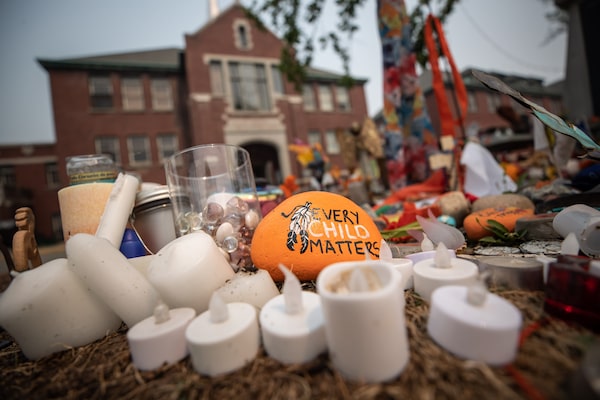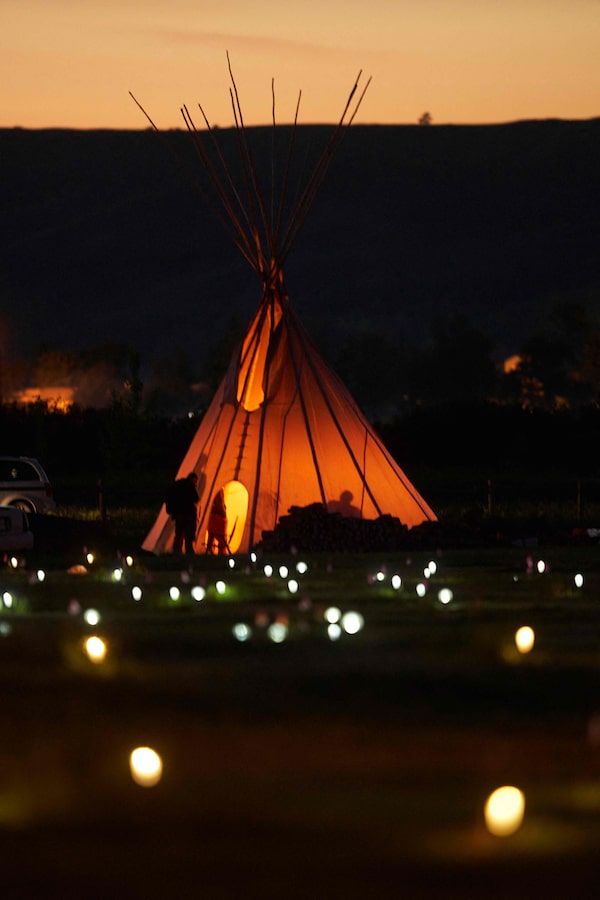
A memorial sits outside the former Kamloops Indian Residential School on July 15, the day the Tk’emlúps te Secwépemc First Nation released a report outlining more findings of the search for unmarked graves.Darryl Dyck/The Canadian Press
From coast to coast, Indigenous people have long suspected that former residential schools – colonial institutions designed to separate children from their cultures – still had unmarked graveyards that hid their horrific human cost. Hundreds of such graves have been reported this summer as First Nations have used ground-penetrating radar, archival detective work and the help of experts to find the remains of long-lost loved ones.
Three such communities – Cowessess in Saskatchewan, and Tk’emlúps te Secwépemc and Ktunaxa in B.C. – have gotten most of the attention this summer, but they aren’t the only ones with unmarked graves and won’t be the last to be brought to light. Here’s a primer on what’s they’ve found and how it’s rekindled Canadians’ conversations about the colonial legacy, reconciliation and what should be done to give the children’s remains proper respect.
Need to talk with someone? There is a national Indian Residential School Crisis Line (1-866-925-4419). In B.C., a toll-free First Nations and Indigenous Crisis Line (1-800-588-8717) is offered through the KUU-US Crisis Line Society.
What’s been found at the residential school sites
Marieval Indian Residential School

A tepee on the Cowessess First Nation is surrounded by solar lights and flags that mark the spots where human remains were discovered.GEOFF ROBINS/AFP via Getty Images
- Where: Cowessess First Nation in Saskatchewan, east of Regina
- Findings: There are 751 unmarked graves in the Catholic cemetery near the former school, Chief Cadmus Delorme announced on June 23 in the initial findings of a Cowessess-led investigation that began earlier that month. The chief stressed that it is “not a mass grave site,” but unmarked individual graves containing both child and adult remains, and the investigation will address why any markers that once existed were removed.
- About the school: Marieval operated from the late 1890s to 1997, at first under various Catholic missionary orders, then the federal government from 1968 to 1981, and then local First Nations administrators (who argued closing it would put children at greater risk in foster care or schools farther away). The school building was demolished in 1999 and replaced with a day school.
Kamloops Indian Residential School
Lights illuminate shoes and stuffed toys outside the site of the former Kamloops Indian Residential School.Jennifer Gauthier/Reuters
- Where: Tk’emlúps te Secwépemc First Nation, near Kamloops, B.C.
- Findings: On May 27, the First Nation said unmarked graves held the remains of 215 children. But the total won’t be clear until dozens of acres of territory are searched, the expert who conducted the first scans said at a July 14 news conference. Previously, the Truth and Reconciliation Commission’s registry could confirm only 51 deaths at Kamloops from 1914 to 1963, but the Tk’emlúps community long believed that more remains were nearby. This year, a government grant allowed the First Nation to bring in a team led by Sarah Beaulieu of the University of the Fraser Valley to scan two acres near an apple orchard on the South Thompson River. The search turned up a juvenile rib bone, and a Simon Fraser University team later found a child’s tooth, Dr. Beaulieu says.
- About the school: Kamloops was at one point the largest of Canada’s residential schools. It operated from 1890 to 1969, mostly under a Catholic order called the Oblates of Mary Immaculate, but the federal government ran it as a day school for nine more years before it closed in 1978.
St. Eugene’s Mission School
St. Eugene’s Mission School in Cranbrook operated from 1912 to 1970.
- Where: Ktunaxa Nation, near Cranbrook, B.C.
- Findings: Aqam, one of four bands that make up the Ktunaxa Nation, went looking for unmarked graves in its cemetery after an incident last year when an unknown grave was disturbed there. They found 182 unmarked graves, according to preliminary results made public on June 30.
- About the school: The Catholic Church ran St. Eugene’s (originally called the Kootenay Indian Residential School) from 1912 until 1970. The site is now home to a resort and casino owned by Ktunaxa communities and the Shuswap Indian Band.
How does ground-penetrating radar work?

Ground penetrating radar, or GPR, is increasingly
being seen as an effective tool to locate
unmarked gravesites, such as those believed to
be present around Canada’s residential schools.
But experts say the work requires careful meth-
odology, protocols and standards to ensure the
findings are accurate and warn that the stakes
are high.
Sites are divided into grids to ensure accurate data collection
Monitor
Operator
Antenna
Control
unit
High-
frequency
radio waves
GPR works by passing back and forth over a
gridded survey site with a portable cart-mounted
unit. The control unit emits a continuous series of
high-frequency radio waves, which pass through
the ground. The strength and rate at which this
electromagnetic energy is reflected back from
various materials is measured. Different substanc-
es have various capacities to store or reflect elec-
trical energy; metal has a high capacity to reflect
energy, while dry sand has much less. The data is
then displayed as a radargram that can be inter-
preted by experts.
Example of
a GPR cross-
sectional
radargram
JOHN SOPINSKI AND murat yükselir /THE
GLOBE AND MAIl, sources: leica; geomodel
inc. (radargram); sensors and software
inc.; groundpenetratingradar.co.uk; geo-
physical.com

Ground penetrating radar, or GPR, is increasingly
being seen as an effective tool to locate unmarked
gravesites, such as those believed to be present
around Canada’s residential schools. But experts say
the work requires careful methodology, protocols and
standards to ensure the findings are accurate and
warn that the stakes are high.
Sites are divided into grids to ensure accurate data collection
Monitor
Operator
Antenna
Control
unit
High-
frequency
radio waves
GPR works by passing back and forth over a gridded
survey site with a portable cart-mounted unit. The
control unit emits a continuous series of high-fre-
quency radio waves, which pass through the ground.
The strength and rate at which this electromagnetic
energy is reflected back from various materials is
measured. Different substances have various capaci-
ties to store or reflect electrical energy; metal has a
high capacity to reflect energy, while dry sand has
much less. The data is then displayed as a radargram
that can be interpreted by experts.
Example of
a GPR cross-
sectional
radargram
JOHN SOPINSKI AND murat yükselir /THE GLOBE AND
MAIl, sources: leica; geomodel inc.(radargram);
sensors and software inc.; groundpenetratingra-
dar.co.uk; geophysical.com

Ground penetrating radar, or GPR, is increasingly being seen as an
effective tool to locate unmarked gravesites, such as those believed
to be present around Canada’s residential schools. But experts say
the work requires careful methodology, protocols and standards to
ensure the findings are accurate and warn that the stakes are high.
Monitor
Operator
Antenna
Control
unit
High-
frequency
radio waves
Sites are divided into grids to ensure accurate data collection
GPR works by passing
back and forth over a
gridded survey site with
a portable cart-mounted
unit. The control unit
emits a continuous series
of high-frequency radio
waves, which pass
through the ground. The
strength and rate at which
this electromagnetic
energy is reflected back
from various materials is
measured. Different sub-
stances have various
capacities to store or
reflect electrical energy;
metal has a high capacity
to reflect energy, while
dry sand has much less.
The data is then displayed
as a radargram that can
be interpreted by experts.
JOHN SOPINSKI AND murat
yükselir /THE GLOBE AND
MAIl, sources: leica; geo-
model inc. (radargram);
sensors and software inc.;
groundpenetratingradar.
co.uk; geophysical.com
Example of
a GPR cross-
sectional
radargram
What is a residential school? Some context
An Anglican priest leads a funeral procession for a student around 1920 at Shingwauk Indian Residential School in Sault Ste. Marie, Ont.Shingwauk Residential Schools Centre, Algoma University
Who ran residential schools in Canada?
From the 1870s to the 1990s, residential schools were part of a systematic federal policy to assimilate Indigenous children into European culture, based on racist assumptions that their own cultures were inferior.
Children were separated from their families and lived in poorly funded schools where federal- or church-run staffs punished them for speaking their own languages. Physical and sexual abuse, malnutrition and disease were common. The last school in the country closed in 1997.
Survivors pressed the government and churches for compensation and apologies, a process that led to a $2-billion settlement and the creation of the TRC. Its final report in 2015, based on interviews with more than 6,000 witnesses, said the schools amounted to cultural genocide and are inseparable from the present-day problems Indigenous people face, from high rates of poverty, suicide and incarceration to the loss of Indigenous lands and traditions.
How many people died at residential schools?
The TRC’s Missing Children Project has so far documented more than 4,100 deaths in the schools, but the full tally could be as high as 6,000.
The 2015 report noted huge gaps in the available records of deceased students’ names, genders or even causes of death. Six of the TRC’s “calls to action” (71 to 76) have to do with missing children and burials, and demand a clear plan to tell families where their lost loved ones are buried and make sure cemeteries are well maintained.
How many residential schools were there in Canada?
There were 138 residential schools reviewed by the TRC, highlighted in the map below. Most of the school buildings have been demolished, but some were converted to other uses: The Mohawk Institute Residential School in Brantford, Ont., is reopening in 2024 as an educational and tourism facility, the Woodland Cultural Centre, after a restoration organized by survivors, historians and museum consultants.

Hudson
Bay
Kamloops
St. Anne’s
Shubenacadie
St. Mary’s
Gordon’s
Portage
la Prairie
UNITED STATES
THE GLOBE AND MAIL
SOURCE: truth and reconciliation commission

Hudson
Bay
Kamloops
St. Anne’s
Shubenacadie
St. Mary’s
Gordon’s
Portage
la Prairie
UNITED STATES
THE GLOBE AND MAIL
SOURCE: truth and reconciliation commission

YUKON
NWT
NUNAVUT
Hudson
Bay
B.C.
ALTA.
N.L.
SASK.
MAN.
Kamloops
St. Anne’s
QUE.
PEI
ONT.
Shubenacadie
St. Mary’s
Gordon’s
N.B.
Portage
la Prairie
N.S.
UNITED STATES
THE GLOBE AND MAIL, SOURCE: truth and reconciliation commission
What will it cost to find all the unmarked graves?
Several nations near school sites are pressing for government help to search for unmarked graves, a call supported by the Assembly of First Nations, the UN Human Rights Office and other groups. As of late June, Indigenous Services Canada said it had received more than 100 requests. In Ontario, for instance, Six Nations of the Grand River is asking for $10-million, the estimated cost of an archeological search, forensic examination and psychological and spiritual supports for the community. If similar estimates are applied to all the TRC-reviewed schools, it would add up to more than $1-billion.
The Trudeau government has offered a lot less than that. In the 2019 budget, it earmarked $27-million to search for graves, but didn’t make it available until after the Kamloops findings were announced. MPs from all parties also passed a non-binding NDP motion that demanded the government speed up efforts to pay for search and identification efforts.
Madelyn Severight, 4, lays a flower back down before a candlelight vigil at the Saskatchewan legislature in Regina on Canada Day.David Stobbe/Reuters
New calls for action
Finding more unmarked graves is only one of the things Indigenous leaders and advocates are pressing Ottawa to do to help residential-school survivors and follow through on the TRC’s recommendations. These include:
- Action at the Vatican: A papal apology for residential schools was one of the goals recommended by the TRC, and Mr. Trudeau has asked the Vatican to make that happen, without result. Pope Francis spoke about the Kamloops graves at a Sunday service on June 6, but it wasn’t an apology; instead, he expressed his “closeness with the Canadian people” and said political and religious authorities should “continue to collaborate with the determination to shed light on this sad affair and to commit humbly to a path of reconciliation and healing.”
- Monuments and naming: Governments and public institutions are under renewed pressure to take down monuments or rename institutions that honour people who helped build the residential-school system in the 19th century, such as prime minister Sir John A. Macdonald and educator Egerton Ryerson. In Toronto, a Ryerson statue was torn down by protesters at the university named after him; in Charlottetown, city council voted to permanently remove a Macdonald statue that they had previously considered keeping with new signage.
- Oaths: Two of the TRC’s calls to action involved changing the Canadian citizenship oath to include references to Indigenous people and treaty obligations, and the federal government has fast-tracked a bill, C-8, to do that. It still needs to pass the Senate. The new oath would read: “I swear (or affirm) that I will be faithful and bear true allegiance to Her Majesty Queen Elizabeth the Second, Queen of Canada, Her Heirs and Successors, and that I will faithfully observe the laws of Canada, including the Constitution, which recognizes and affirms the Aboriginal and treaty rights of First Nations, Inuit and Métis peoples, and fulfill my duties as a Canadian citizen.”
- Day of commemoration: Federal MPs were already nearing the final vote on C-5, a bill to make Sept. 30 a national day to commemorate residential-school victims and survivors, when the Kamloops discovery was made public. The bill was approved in the House and Senate and received royal assent in quick succession.
More reading
Indigenous voices
The Kamloops site is a crime scene. When will Canada take responsibility for bringing about justice?
Jody Wilson-Raybould: Unmarked graves are a painful reminder of why we need leadership
Indigenous poet Jordan Abel explores legacy of residential schools in mixed-media book
Michelle Good’s debut novel, Five Little Indians, chronicles the aftermath of residential school

The Decibel podcast
Will the Pope apologize for residential schools?
'It's unfathomable': Canada's lost residential school children
Commentary: The church’s role
Compiled by Globe staff
With reports from Jana G. Pruden, Mike Hager, Kristy Kirkup, Patrick White, Carrie Tait, Andrea Woo, Kate Taylor, Tavia Grant, Jeffrey Jones and The Canadian Press